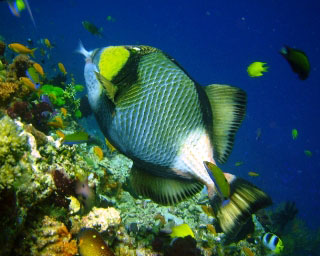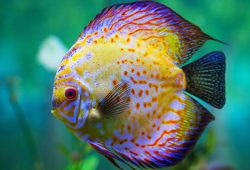Triggerfishes for the Fish-Only Tank
In the article I’m going to tell you about Triggerfishes for the Fish-Only Tank. Most triggerfishes are not reef safe, but in a fish-only aquarium, these beautiful fishes can easily become the centerpiece of a spectacular display.

While there are several triggerfish species considered reef safe by the experienced aquarist, most triggerfishes are only appropriate for the fish-only system. This article takes a brief look at four genera of triggerfishes readily available to the hobbyist:
- Sufflamen
- Rhinecanthus
- Balistapus
- Pseudobalistes
The triggerfishes belonging to these genera should be expected to consume any and all invertebrates or anything else they can fit in their mouth.
Contents
Triggerfishes from the Genus Sufflamen
Triggerfish from the genus Sufflamen are favorites for the fish-only marine aquarium. Species in this genus are considered by many to be the most peaceful triggerfishes available to the hobbyist. They remain relatively small—most under a foot—and some hobbyists contend that certain species, such as the whitetail trigger (S. albicaudatus), are even reef-safe. The exquisite lei triggerfish (S. bursa) is one of the best species in the genus and, in some aquarist’s opinion, the best triggerfish of all for a fish-only system.
Triggerfishes from the Genus Rhinecanthus
There are seven species in the genus Rhinecanthus, and all are suitable choices for the fish-only tropical marine aquarim. While they tend to present as peaceful community fishes when young, members of this genus are particularly noted for their aggression as they reach adulthood, and as such, should only be kept with larger or other suitably aggressive fishes. Species in this genus, like the readily available Humuhumu or Picasso trigger (R. aculeatus), are some of the most personable marine fishes, although they are renowned for rearranging the aquarium.
Triggerfishes from the Genus Balistoides
Triggerfish from the genus Balistoides, such as the clown triggerfish (B. conspicillum), are quite territorial and aggressive, and care should be taken to provide optimal conditions for them and their tankmates. “Caution should be taken when adding a clown triggerfish to even a very aggressive aquarium,” says Mark Martin, director of marine ornamental research at Blue Zoo Aquatics and author of The Complete Idiot’s Guide to Saltwater Aquariums (Alpha 2009).
“The clown trigger is a great fish, but it has a Jekyll and Hyde personality.” Martin explains that clown triggers can prove to be peaceful for months, sometimes even years, and then “suddenly start attacking and even killing tankmates several times its size.” Most, if not all, species in this genus should only be kept with larger, more aggressive fish like large angelfishes, pufferfishes and large tangs.
Triggerfish from the Genus Pseudobalistes
Similar to the above genus, species in the genus Pseudobalistes should only be kept with larger, more aggressive fish. While some species in the genus make good tankmates in a community tank as juveniles, as adults they will almost certainly turn on any tankmate not able to defend itself. Nonetheless, some species in the genus, such as the gaudy blueline triggerfish (P. fuscus), are both an attractive and desirable fish for the aquarist with the proper set-up. While all triggerfish may rearrange the aquascaping, the aforementioned Blueline Triggerfish is probably the most adept at redecorating.
Fantastic Triggerfishes for Fish-Only Saltwater Aquarium Set-Ups
While the triggerfishes mentioned in this article are not good candidates for the reef tank, they are all worthy of consideration for the large fish-only system. Once again, as with most marine fishes, it is essential to carefully research any species before adding it to a new or existing system. Provided with the right conditions and husbandry, the triggerfishes mentioned in this article can all make fascinating and beautiful centerpiece fishes.



